1993 CHEVROLET ASTRO PASSENGER change time
[x] Cancel search: change timePage 283 of 345
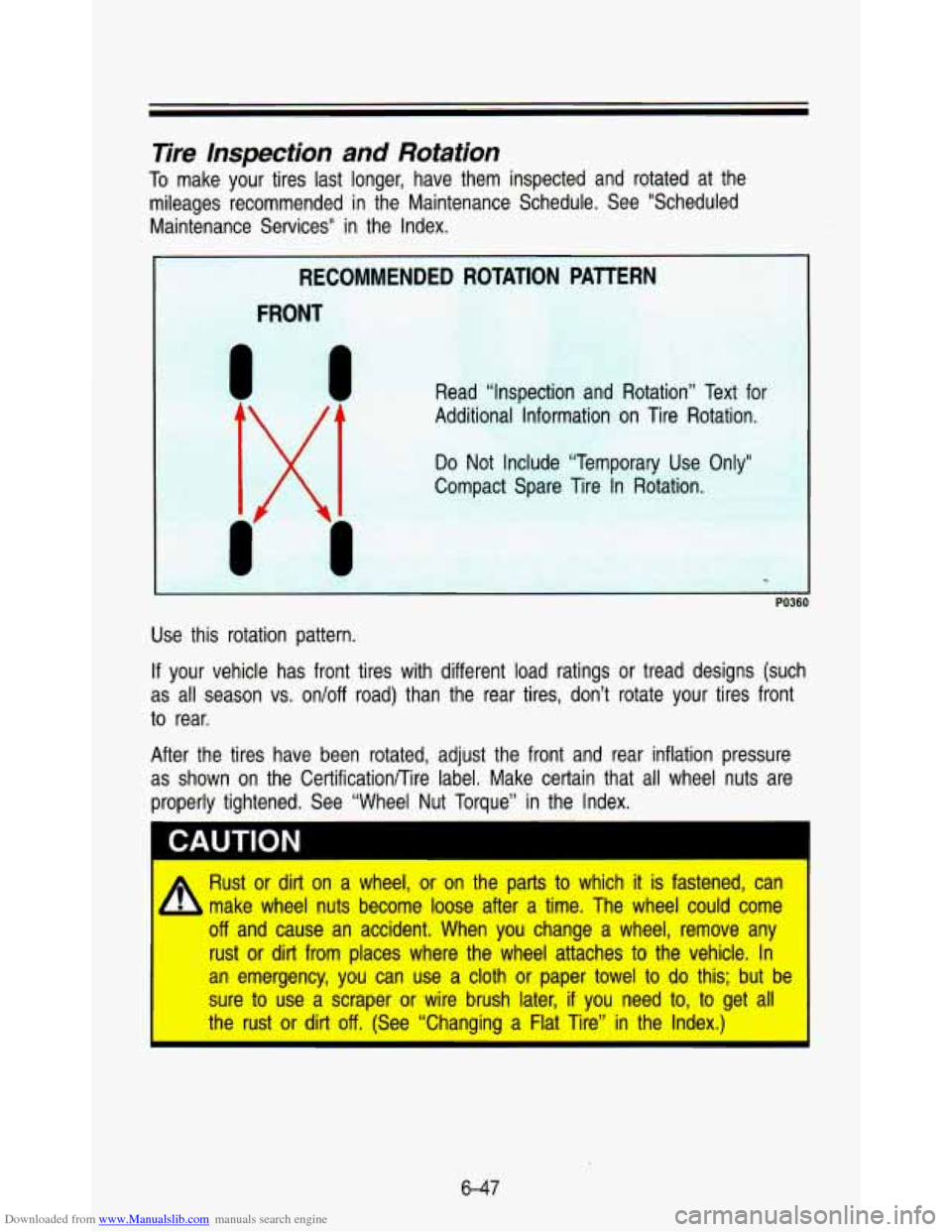
Downloaded from www.Manualslib.com manuals search engine Tire Inspection and Rotation
To make your tires last longer, have them inspected and rotated a\
t the
mileages recommended in the Maintenance Schedule. See “Scheduled
Maintenance Services” in the Index.
Use this rotation pattern.
If your vehicle has front tires with different load ratings or tread designs (such
as all season vs. on/off road) than the rear tires, don’t \
rotate your tires front
to rear.
After the tires have been rotated, adjust the front and rear inflation pressure
as shown on the CertificationRire label. Make certain that all wheel nuts are
properly tightened. See “Wheel Nut Torque” in the Index.
CAUTION I
Rust or dirt on a wheel, or on the parts to which it is fastened, can
make wheel nuts become loose after a time. The wheel could come
.. off and cause an accident. When you change a wheel, remove an\
y
- - .-..-rust. -o,r dit-.from places where the wheel attaches to the vehicle. In
an emergency, you can use a cloth or paper towel to
do this; but be
sure
to use a scraper or wire brush later, if you need to, to get all
the rust or dirt off. (See “Changing a Flat Tire” in the Index.)
I
6-47
Page 300 of 345
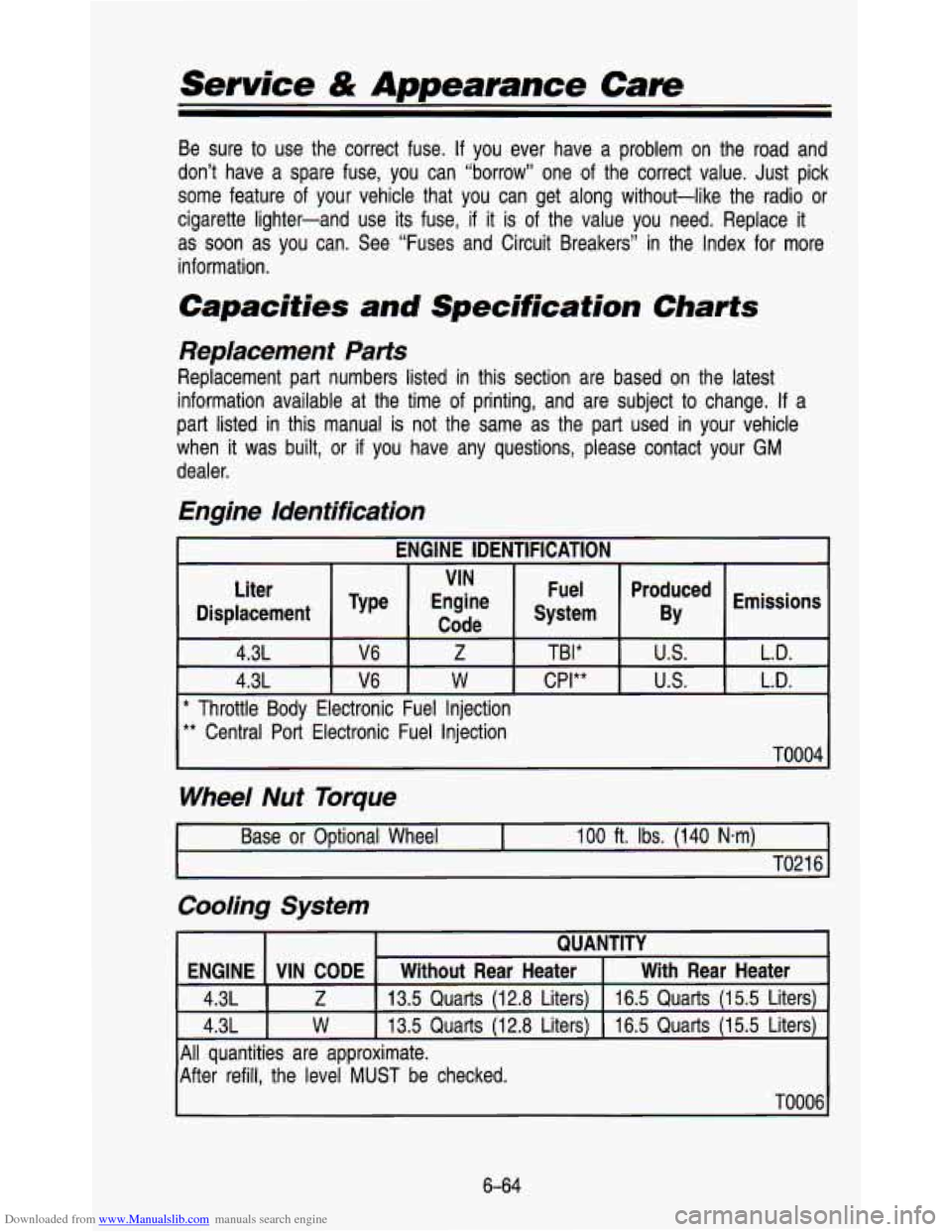
Downloaded from www.Manualslib.com manuals search engine Service & Appearance Cam
Be sure to use the correct fuse. If you ever have a problem on the road and
don’t have a spare fuse, you can “borrow” one of the correct value. Just pick
some feature of your
cigarette lighter-and
as soon
as you can.
information.
Capacities
vehicle that you can get along without-like the radio or
use its fuse,
if it is of the value you need.. Replace it
See “Fuses and Circuit Breakers” in the Index for more
and Specification Charts
Replacement Parfs
Replacement part numbers listed in this section are based on the latest
information available at the time of printing, and are subject to change.
If a
part listed in this manual is not the same as the part used in your vehicle
when
it was built, or if you have any questions, please contact your GM
dealer.
Engine Identification
IGINE IDENTIFICATION
Liter VIN
Fuel
Code
BY Displacement System
Engine
Type
Produced Emissions
4.3L
L.D. U.S. CPI** W V6 4.3L L.D.
us. TBI* Z V6
* Throttle Body Electronic Fuel Injection
** Central Port Electronic Fuel Injection
~0004
Wheel Nut Torque
I Base or Optional Wheel I 100 ft. Ibs. (140
N-m) I
I TO21 6 I
Cooling System
ENGINE With Rear Heater
Without Rear Heater
VIN CODE
QUANTITY
4.3L I Z
16.5 Quarts (1 5.5 Liters)
13.5 Quarts (1 2.8 Liters)
4.3L I w
16.5 Quarts (I 5.5 Liters) 13.5 Quarts (1 2.8 Liters)
All quantities are approximate.
After refill, the level
MUST be checked.
TO006
6-64
Page 314 of 345
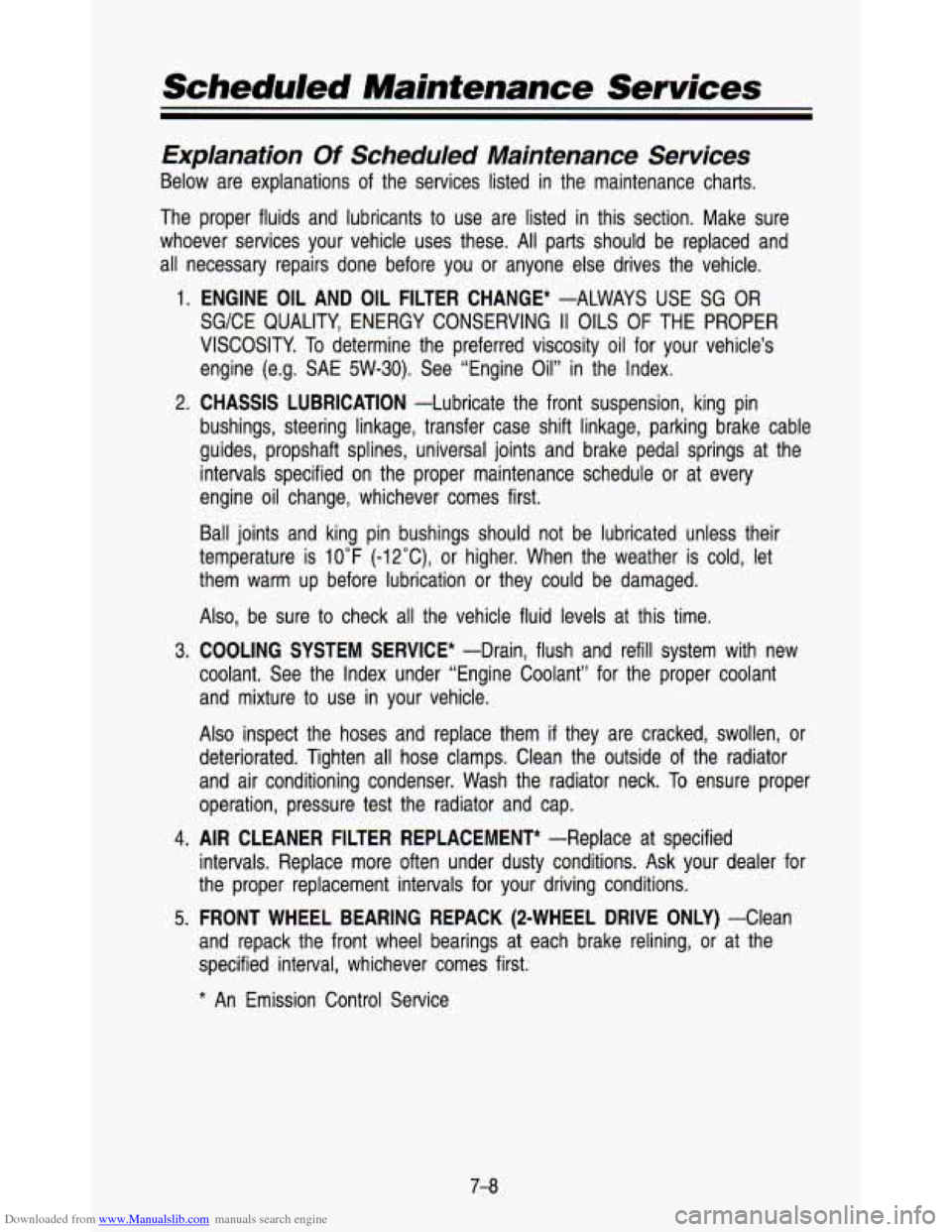
Downloaded from www.Manualslib.com manuals search engine Scheduled Maintenance Services
Explanation Of Scheduled Maintenance Services
Below are explanations of the services listed in the maintenance charts.
The proper fluids and lubricants to use are listed in this section. Make sure
whoever services your vehicle uses these. All parts should be \
replaced and
all necessary repairs done before you or anyone else drives th\
e vehicle.
1. ENGINE OIL AND OIL FILTER CHANGE* -ALWAYS USE SG OR
SG/CE QUALITY, ENERGY CONSERVING II OILS OF THE PROPER
VISCOSITY.
To determine the preferred viscosity oil for your vehicle’s
engine (e.g. SAE 5W-30). See “Engine Oil” in the Index.
bushings, steering linkage, transfer case shift linkage, parking \
brake cable
guides, propshaft splines, universal joints and brake pedal spri\
ngs at the
intervals specified on the proper maintenance schedule or at ev\
ery
engine oil change, whichever comes first.
2.
CHASSIS LUBRICATION -Lubricate the front suspension, king pin
Ball joints and king pin bushings should not be lubricated unl\
ess their
temperature is
10°F (-12”C), or higher. When the weather is cold, let
them warm up before lubrication or they could be damaged.
Also, be sure to check all the vehicle fluid levels at this time.
3.
COOLING SYSTEM SERVICE* -Drain, flush and refill system with new
coolant. See the Index under “Engine Coolant” for the pro\
per coolant and mixture to use in your vehicle.
Also inspect the hoses and replace them
if they are cracked, swollen, or
deteriorated. Tighten all hose clamps. Clean the outside of the radiator
and air conditioning condenser. Wash the radiator neck.
To ensure proper
operation, pressure test the radiator and cap.
4. AIR CLEANER FILTER REPLACEMENT* -Replace at specified
intervals. Replace more often under dusty conditions. Ask your \
dealer for
the proper replacement intervals for your driving conditions.
5. FRONT WHEEL BEARING REPACK (2-WHEEL DRIVE ONLY) -Clean
and repack the front wheel bearings at each brake relining, or at the
specified interval, whichever comes first.
* An Emission Control Service
Page 316 of 345
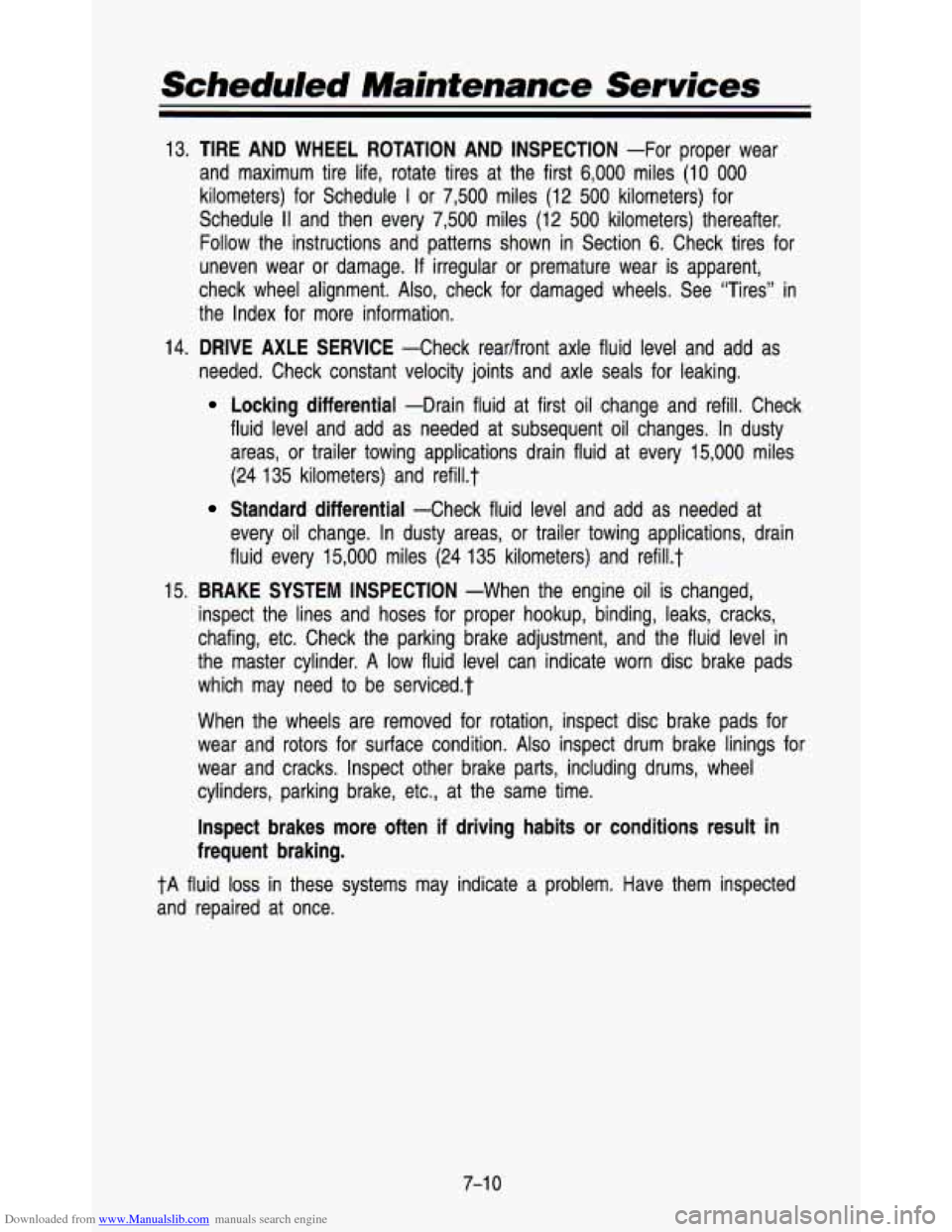
Downloaded from www.Manualslib.com manuals search engine 13. TIRE AND WHEEL ROTATION AN- INSPECTION -For proper wear
and maximum tire life, rotate tires at the first
6,000 miles (1 0 000
kilometers) for Schedule I or 7,500 miles (12 500 kilometers) for
Schedule
II and then every 7,500 miles (12 500 kilometers) thereafter.
Follow the instructions and patterns shown in Section
6. Check tires for
uneven wear or damage.
If irregular or premature wear is apparent,
check wheel alignment.
Also, check for damaged wheels. See “Tires” in
the Index for more information.
14.
DRIVE AXLE SERVICE -Check readfront axle fluid level and add as
needed. Check constant velocity joints and axle seals for leaki\
ng.
Locking differential -Drain fluid at first oil change and refill. Check
fluid level and add as needed at subsequent oil changes. In d\
usty areas, or trailer towing applications drain fluid at every 15,000 miles
(24 135 kilometers) and refi1l.t
Standard differential -Check fluid level and add as needed at
every oil change. In dusty areas, or trailer towing application\
s, drain
fluid every
15,000 miles (24 135 kilometers) and refi1l.t
15.
BRAKE SYSTEM INSPECTION -When the engine oil is changed,
inspect the lines and hoses for proper hookup, binding, leaks, \
cracks,
chafing, etc. Check the parking brake adjustment, and the fluid\
level in
the master cylinder.
A low fluid level can indicate worn disc brake pads
which may need
to be serviced$
When the wheels are removed for rotation, inspect disc brake p\
ads for
wear and rotors for surface condition.
Also inspect drum brake linings for
wear and cracks. Inspect other brake parts, including drums, wh\
eel
cylinders, parking brake, etc., at the same time.
Inspect brakes more often if driving habits or conditions result in
frequent braking.
tA fluid loss in these systems may indicate a problem. Have them inspected
and repaired at once.
7-1 0
Page 327 of 345
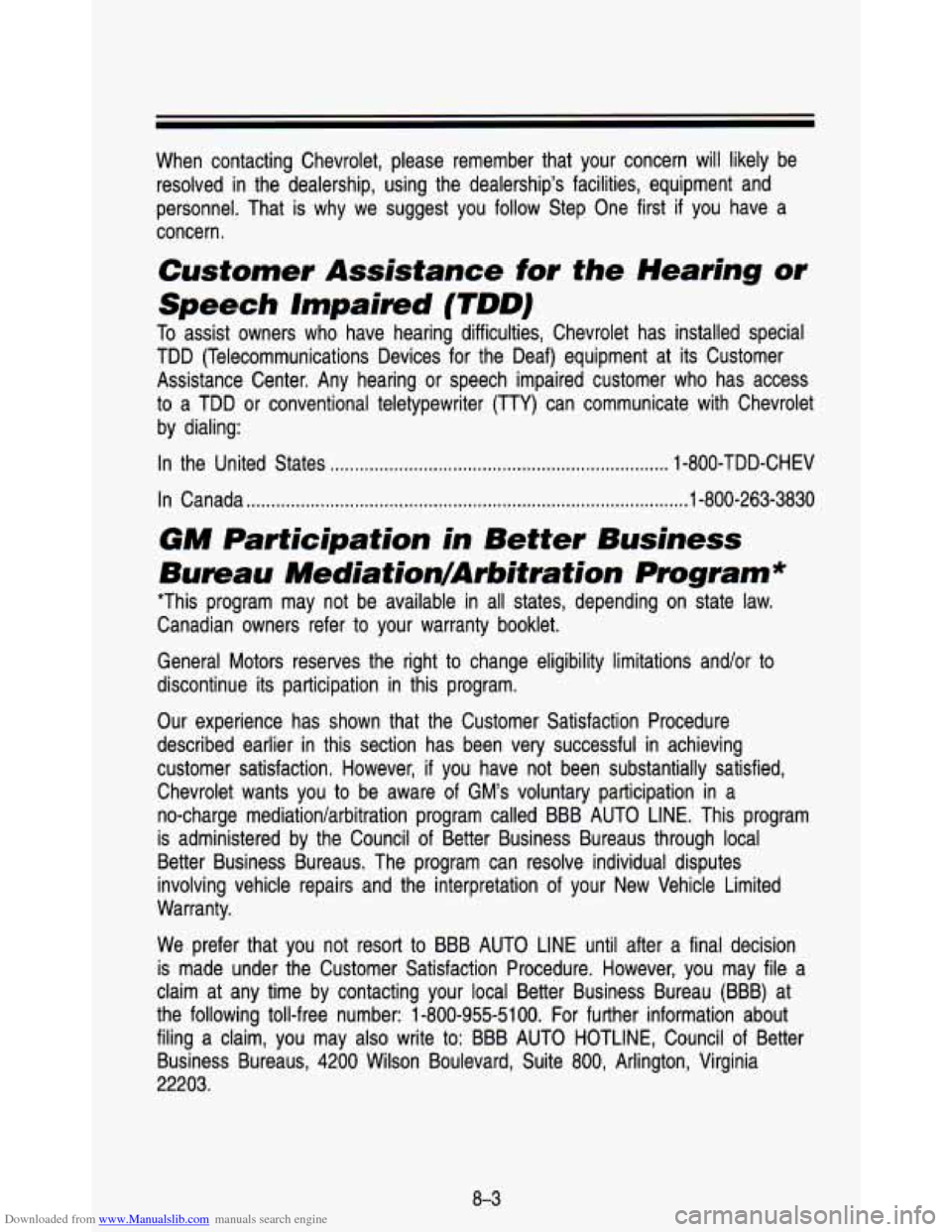
Downloaded from www.Manualslib.com manuals search engine When contacting Chevrolet, please remember that your concern wil\
l likely be resolved in the dealership, using the dealership's facilities, equipment and
personnel. That is why we suggest you
follow Step One first if you have a
concern.
Customer Assistance for the Hearing or
Speech Impaired (TOO)
To assist owners who have hearing difficulties, Chevrolet has insta\
lled special
TDD (Telecommunications Devices for the Deaf) equipment at its\
Customer
Assistance Center. Any hearing
or speech impaired customer who has access
to a TDD or conventional teletypewriter
(TTY) can communicate with Chevrolet
by dialing:
In the United States
..................................................................... 1 -800-TDD-CHEV
In Canada
........................................................................\
.................. 1-800-263-3830
GM Participation in Better Business
Bureau Mediation/Arbitration
Program"
*This program may not be available in all states, depending on state law.
Canadian owners refer to your warranty booklet.
General Motors reserves the right to change eligibility limitati\
ons and/or to
discontinue its participation in this program.
Our experience has shown that the Customer Satisfaction Procedur\
e
described earlier in this section has been very successful in achieving
customer satisfaction. However,
if you have not been substantially satisfied,
Chevrolet wants you to be aware of GM's voluntary participation in a
no-charge mediationlarbitration program called BBB AUTO LINE. This program
is administered by the Council
of Better Business Bureaus through local
Better Business Bureaus. The program can resolve individual disp\
utes
involving vehicle repairs and the interpretation of your New Vehicle Limited
Warranty.
We prefer that you not resort to BBB AUTO LINE until after a final decision
is made under the Customer Satisfaction Procedure. However, you may\
file a
claim at any time by contacting your local Better Business Bur\
eau (BBB) at
the following toll-free number:
1-800-955-51 00. For further information about
filing a claim, you may also write to: BBB AUTO HOTLINE, Council of Better
Business Bureaus,
4200 Wilson Boulevard, Suite 800, Arlington, Virginia
22203.
8-3